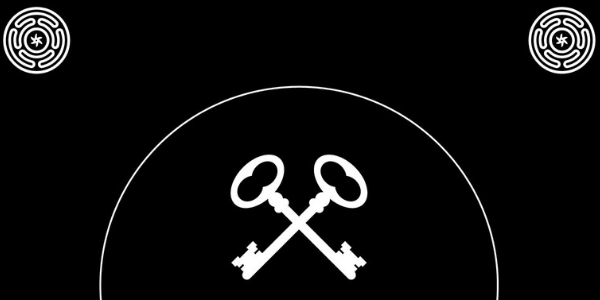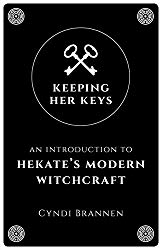
Keeping Her Keys: An Introduction to Hekate’s Modern Witchcraft, by Cyndi Brannen
Moon Books, 9781789040753, 255 pp., 2019
The goddess Hekate is a figure with many forms: goddess of witches, psychopomp, torch barrier, goddess of the crossroads, speaker of the dead, and triple goddess. Her history is just as diverse and hidden in the shadows as the realm she walks. Keeping Her Keys: An Introduction to Hekate’s Modern Witchcraft by Cyndi Brannen is an introduction to Hekate with a overview and brief history of how Hekate has been perceived over time. It also gives sources in the back to do further research. This is less a history of Hekate, but more of a workbook to building a lasting connection with the goddess in a modern witchcraft sense.
I have personally been working with Hekate off and on since the late ’90s early 2000s in some form or other, but in the last couple years I have dug deeper to see what Hekate means to me on a personal and spiritual level. Hekate came along veiled face, torches held high, heavy iron keys clanking on her hip and a subtle “about damn time” air about her. She has so many forms and titles; I see her at the crossroads and in the underworld speaking to the dead as a veiled lady. Keeping Her Keys is an amazing find, filled with information on what we know of her in antiquity and how we can interpret that in a modern way. This not reconstructionism, but rather it utilizes the history within a modern practice of witchcraft.
Cyndi Brannen is a teacher and blogger that has site with the same name (keepingherkeys.com), where she posts historical research about modern witchcraft. Brannen presents spells, prayers, and hymns of both ancient and modern verse to Hekate. Her blog is a subjective collection of her personal work, with the research of what we know of the goddess woven through. I will admit some bias in reading this book due to enjoying the blog over the last few years. I would recommend anyone wanting to read Keeping Her Keys to also read Brannen’s blog as well for further study and ideas. They are not the end all, but a starting point.
This book is formatted into 13 weeks of exercises, ending in a self-initiation. It works with the lunar cycle, starting on the dark moon and working through each lunar cycle, that acts similar to the year and a day Wiccan practice of initiates to learn and build on each lesson to create a rounded understanding of Hekate from both a knowledge, devotion, and magical base. Brannen goes through what this book means and how best to utilize the work. However, I do wish there was a clearer divider between weeks and sections, but this doesn’t take away from its usefulness.
I was happy see how much Brannen drills in the importance to journalling. This is something I think the Pagan community is bringing up more than ever, since all our work is subjective. Also, our memories are lousy, and we have multiple mediums to utilize to record our work. Each section has a exercise that includes journalling afterwards and focus.
In the back of the book, Brannen organized additional prayers along with a quiz on the 13 lessons. This book gives structure for each week to focus but also gives wiggle room to build in one’s own connection with Hekate.
Keeping Her Keys is not just a book of spells to get something out of Hekate, this is a book that focuses on building a give and take with her and to not just send off a spell and forget it or calling on her when something is needed.
There are so many mutual benefits in our relationship with Hekate. However, we need to be mindful of establishing a healthy relationship. Being sincere in our devotion and trying to live a magical life will help get this relationship off to a good start.1
It also reminds the reader to look for signs through symbol sets such as keys, torches, strophalos (Hekate’s wheel) in everyday life and to also keep track of dreams since “our busy minds are quieted by sleep, allowing our establishing connection with our Lady to flow more freely,”2 which can then be reviewed later to see what connections can be made. Along with various divination exercises, Brannen also goes into more detail of the various symbols used beyond the key and torch, such as the animals like snakes and dogs that are shown on ancient coins. She writes that even though the strophalos might not be directly tied to Heckate, it has come to be such a strong symbol for her in modern times that is worn and even tattooed on devotees. This is just one example of an image that may not have originally came with Hekate, but has now become a strong symbol of association with the passage of time.
The 13 lesson is spellcrafting, which first explains the various kinds such as banishing, binding, attraction, healing, and so forth. The final lesson is building a spell from the ground up by figuring out what kind of spell is intended, setting on the intentions, knowing what tools are needed, and deciding when it should be done and what aspect of Hekate is the focus. This is great since people often want to jump right into the spells and essentially run before walking. This method gives a stronger foundation to work on if they are new to all of this. “This course started with lots of information and exercises about personal development and why we do the practices that make up our Witch’s Hour of Power. Because there is no separation between our witchery and who we are.”3
This all culminates with the self-initiation and even goes into being solitary or finding a mentor “When selecting a mentor or a teacher, do your research and use your intuition before committing to anything,”4 which is great advice to any practitioner. Though we want to find a coven of like-minds or that amazing teacher, sometimes we must walk alone to understand what we want and what our true will is. Hekate in this book is just a guiding light to better reflect what is already there.
Keeping Her Keys is a springboard towards making a firmer connection with the elusive Hekate. The author shows that her version of Hekate may not be the same as the reader’s, but she wants to give method to help readers connect with that version they have, as well as her own. I would recommend that this book be read front to back first — before using it as a 13 week workbook.








